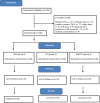Comparison of Efficacy of Adductor Canal Block, Local Infiltration Analgesia and Both Combined in Postoperative Pain Management After Total Knee Arthroplasty: A Randomized Controlled Trial
- PMID: 34824710
- PMCID: PMC8586381
- DOI: 10.1007/s43465-021-00482-7
Comparison of Efficacy of Adductor Canal Block, Local Infiltration Analgesia and Both Combined in Postoperative Pain Management After Total Knee Arthroplasty: A Randomized Controlled Trial
Abstract
Purpose: The aim of our study is to compare the efficacy of adductor canal block (ACB), periarticular local infiltration (PLI) and both combined (ACB + PLI) in multimodal pain management after TKA.
Methods: This is a prospective, randomized controlled double-blinded study undergoing primary unilateral TKA. They were randomized into three groups with fifty patients in each group: ACB alone (30 ml of 0.2% ropivacaine), PLI alone (30 ml 0.5% ropivacaine in 20 ml of normal saline), and both combined (ACB + PLI). The primary outcome studied was pain using visual analog score (VAS) in postoperative days (POD) 1 and 2. The secondary outcomes estimated were the ambulation capacity, the knee range of motion, need for rescue analgesia and length of hospital stay.
Results: The mean VAS score was significantly lower at rest and after mobilization in the combined group (3.51 at POD 1, 2.04 at POD 2), compared with either alone group (ACB = 4.70, 2.86 versus PLI = 4.39, 3.41 at POD 1 and 2 respectively after mobilization, p < 0.001). The ambulation capacity (combined = 103.3 steps versus ACB = 98.1 and PLI = 95.2 steps, p = 0.04) and the knee range of motion (arc of motion 106.7 degrees versus ACB = 104.9 and PLI = 102.2 degrees, p = 0.004) were significantly higher in the combined group compared to the other groups. There was no significant difference in the length of stay between the groups (p = 0.12).
Conclusion: Adductor canal block combined with periarticular local infiltration provides better pain relief, good range of motion, quicker rehabilitation, and reduced opioid consumption.
Keywords: Adductor canal block; Functional outcome; Pain; Periarticular local infiltration analgesia; Total knee arthroplasty.
© Indian Orthopaedics Association 2021.
Conflict of interest statement
Conflict of interestNatesan Rajkumar, Manickam Karthikeyan, Dhanasekaran Soundarrajan, Palanisami Dhanasekararaja and Shanmuganathan Rajasekaran declare that they have no conflict of interest.
Figures



Similar articles
-
Analgesic efficacy of single-shot adductor canal block versus adductor canal block combined with intra-articular ropivacaine infusion after total knee arthroplasty.Bone Jt Open. 2021 Dec;2(12):1082-1088. doi: 10.1302/2633-1462.212.BJO-2021-0119.R1. Bone Jt Open. 2021. PMID: 34931538 Free PMC article.
-
Comparative study of the influence of adductor canal block plus multimodal periarticular infiltration versus combined adductor canal block, multimodal periarticular infiltration and intra-articular epidural catheter ropivacaine infiltration on pain relief after total knee arthroplasty: a prospective study.Musculoskelet Surg. 2020 Aug;104(2):201-206. doi: 10.1007/s12306-019-00613-2. Epub 2019 Jun 25. Musculoskelet Surg. 2020. PMID: 31240665 Clinical Trial.
-
Adductor canal block combined with local infiltration analgesia with morphine and betamethasone show superior analgesic effect than local infiltration analgesia alone for total knee arthroplasty: a prospective randomized controlled trial.BMC Musculoskelet Disord. 2022 May 19;23(1):468. doi: 10.1186/s12891-022-05388-5. BMC Musculoskelet Disord. 2022. PMID: 35590308 Free PMC article. Clinical Trial.
-
Dose adductor canal block combined with local infiltration analgesia has a synergistic effect than adductor canal block alone in total knee arthroplasty: a meta-analysis and systematic review.J Orthop Surg Res. 2019 Apr 11;14(1):101. doi: 10.1186/s13018-019-1138-5. J Orthop Surg Res. 2019. PMID: 30971284 Free PMC article.
-
Adductor canal block combined with local infiltration analgesia versus isolated adductor canal block in reducing pain and opioid consumption after total knee arthroplasty: a systematic review and meta-analysis.J Int Med Res. 2020 Aug;48(8):300060520926075. doi: 10.1177/0300060520926075. J Int Med Res. 2020. PMID: 32776794 Free PMC article.
Cited by
-
Pain control post total knee replacement in patients given local infiltrative analgesia combined with adductor canal block compared to either modality alone: a systematic review and meta-analysis.BMJ Open. 2024 Nov 12;14(11):e080555. doi: 10.1136/bmjopen-2023-080555. BMJ Open. 2024. PMID: 39532366 Free PMC article.
-
Efficacy and Adverse Reactions of Arthroscopic Half-Moon Plate Invasive Surgery in Patients with Acute Knee Pain (AKP): Systematic Review and Meta-Analysis.Appl Bionics Biomech. 2022 Apr 18;2022:4277563. doi: 10.1155/2022/4277563. eCollection 2022. Appl Bionics Biomech. 2022. Retraction in: Appl Bionics Biomech. 2023 Nov 29;2023:9851071. doi: 10.1155/2023/9851071. PMID: 35480709 Free PMC article. Retracted. Review.
-
Clinical Application of Perioperative Anaesthesia Management Based on Enhanced Recovery after Surgery Concept to Elderly Patients Undergoing Total Knee Replacement.Comput Intell Neurosci. 2022 Mar 29;2022:8039358. doi: 10.1155/2022/8039358. eCollection 2022. Comput Intell Neurosci. 2022. Retraction in: Comput Intell Neurosci. 2023 Mar 12;2023:9763172. doi: 10.1155/2023/9763172. PMID: 35392043 Free PMC article. Retracted.
-
Comparative analysis of dual versus single subsartorial block for postoperative analgesia after total knee arthroplasty - A randomized, double-blind study.J Anaesthesiol Clin Pharmacol. 2025 Jul-Sep;41(3):470-477. doi: 10.4103/joacp.joacp_206_24. Epub 2025 Jun 2. J Anaesthesiol Clin Pharmacol. 2025. PMID: 40635828 Free PMC article.
References
-
- Kwofie MK, Shastri UD, Gadsden JC, et al. The effects of ultrasound-guided adductor canal block versus femoral nerve block on quadriceps strength and fall risk: a blinded, randomized trial of volunteers. Regional Anesthesia and Pain Medicine. 2013;38(4):321–325. doi: 10.1097/AAP.0b013e318295df80. - DOI - PubMed
LinkOut - more resources
Full Text Sources
Miscellaneous
